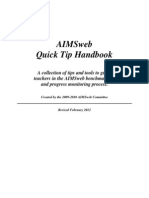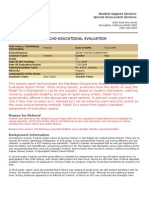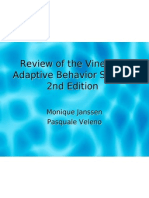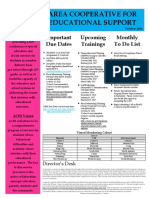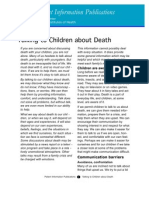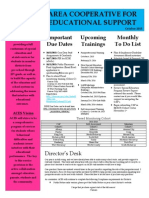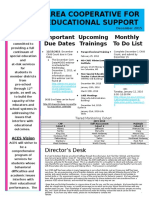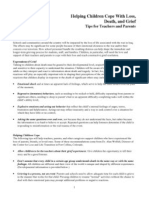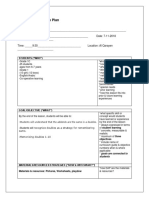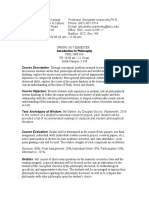Aces Assessment List 2016
Aces Assessment List 2016
Uploaded by
api-83101465Copyright:
Available Formats
Aces Assessment List 2016
Aces Assessment List 2016
Uploaded by
api-83101465Original Title
Copyright
Available Formats
Share this document
Did you find this document useful?
Is this content inappropriate?
Copyright:
Available Formats
Aces Assessment List 2016
Aces Assessment List 2016
Uploaded by
api-83101465Copyright:
Available Formats
ACES Assessment List
Test
Test Name
Abbreviation Date Age Range
Cognitive
Leiter International Performance Scale
Leiter-3
2013
3-75+
Cognitive
Kaufman Achievement Battery-2
KABC-2
2004
3-18:11
Cognitive
Stanford-Binet 5
SB5
2003
2 to 85+
Cognitive
Cognitive
Cognitive
Wechsler Adult Intelligence Scale
Wechsler Pre-K & Primary Scale of Intelligence
Wechsler Intelligence Scale for Children
WAIS-IV
WPPSI-III
WISC-V
Cog/Acad.
Brigance Diagnostic Inventory of Early Development-3
Brig. IED-3
Gen. Acad.
Kaufman Test of Educational Achievement-3
KTEA-III
2014
Gen. Acad.
Woodcock-Johnson-IV Achiev./Oral
WJ-IV
2014
Math
KeyMath-3
Reading
Grays Oral Reading Tests-V
GORT-5
2012
Reading
Test of Early Wr. Lang. Ability-3
TEWL-3
2012
Reading
Test of Oral Reading & Comp-3
TORC-3
1995
Wr. Lang.
Test of Written Language-4
TOWL-4
Adap. Beh.
Adaptive Behavior Evaluation Scale:2
ABES:2
Adap. Beh.
Vineland Adaptive Behavior Scale: 2
Behavior
Behavior Assessment Scale for Children-2
BASC-2
2004
Behavior
Beck Youth Inventories-2
BYI-2
2001
Behavior
Behavior Evaluation Scale-3
BES-3
2005
Behavior
Behavioral & Emotional Rating Scale-2
BERS-2
2004
Description
Nonverbal measure of IQ, memory, and attention, particularly for nonverbal and
ELL students.
Measure of processing and cognitive abilities; includes a nonverbal index
Measure of verbal and nonverbal cognitive abilities, including Fluid Reasoning,
Knowledge, Quantitative Reasoning, Visual-Spatial Processing, Working Memory
2008 16:0-90:11 Measure of cognitive abilities in adults.
2002 2:6-7:3 Measure of cognitive abilities in young children.
2014 6:0-16:11 Measure of cognitive abilities in school-age children.
Measures self-help, psychomotor, communication, gen. knowledge,
2013
0-7
comprehension, acad skills
KeyMath-3 2007
2006
Vineland-2 2005
4:0-25:11 Assessment of academic skills, including reading, math, written & oral language
20 subtests measuring reading, math, written language, and academic knowledge;
oral language
10 subtests organized into three major areas-Basic Concepts, Operations, and
4:6-21
Applications.
Measure of oral reading fluency and comprehension. 16 developmentally
6-23:11
sequenced passages/5 questions each.
Assesses mastery of early developing reading skills; alphabet, conventions, and
4-11:11
meaning.
Measures comprehension with vocab, syntactic similarities, paragraph reading,
7:0-17:11
sent. sequencing.
Provides composite scores in Contrived Writing and Spontaneous Writing and a
9:0-17:11
Total Written Language scores
4:0-12
Measure Personal and social skills in daily life; interpersonal, Play & Leisure,
0-18:11
Coping Skills
Teacher, Parent, & Self-report to understand behaviors, emotions of children and
2:0-21:11
adolescents.
Self-report scales to assess depression, anxiety, anger, disruptive behavior, self7:0-18:11
concept.
To screen for behavior problems, assess behavior, assist in diagnosis of BD/ED,
4:0-19
develop IEP.
5:0-18 To assess behavioral and emotional strengths of children.
2-Adult
ACES Assessment List
Behavior
Clinical Assessment of Behavior
CAB
2004
Behavior
Firestone Assessment of Violent Thoughts-Adolescent
FAVT-A
2008
Autism
Childhood Autism Rating Scale-2
CARS-2
2010
2 & up
Autism
Gilliam Autism Rating Scale-3
GARS-3
2014
3:0-22
Language
Clinical Evaluation of Language Fundamentals-5
CELF-5
2013
5:0-21
Language
Comprehensive Assessment of Spoken Language
CASL
1999
3:0-21
Language
Expressive Vocabulary Test-2
EVT-2
Language
Goldman-Fristoe Test of Artic.-2
GFTA-2
Language
Peabody Picture Vocabulary Test-4
PPVT-4
Language
Pragmatic Langauge Skills Inventory
PLSI
Language
Preschool Language Scale-4
PLS-4
Language
Preschool Language Scale-4/screen
Language
Test of Language Development-4:Intermediate
Language
Test of Language Development-4:Primary
Motor
Bruininks-Osteretsky Test of Motor Proficiency-2
Motor
Peabody Developmental Motor Scales-2
Motor
Sensory Processing Measure
Motor
(Beery) Visual Motor Integration-5
2:0-18:0
Assesses adjustment, psychosocial strengths and weaknesses, problem behavior
Self-report assessment tool designed to assess the underlying thoughts that
predispose violent behavior.
Rating scale to identify children with autism and determine sympton severity.
Screening instrument to identify severe behavior problems that may be indicative
of autism.
Assesses receptive and expressive language.
Measure processes of comprehension, esxpression, and retrieval in categories of
lexical/semantic, syntactic, spralinguistic, and pragmatic language.
Measures expressive vocabulary knowledge. Word rerieval evaluated by
comparing differences between EVT-2 and PPVT-4.
Assess articulation of consonant sounds; sounds-in-words, sounds-in-sentences,
2000
2:0-21
stimulability.
2007 2:0-adult Wide-range test of hearing vocabulary.
2007 2:6 to adult
The Pragmatic Language Skills Inventory (PLSI) is an easy-to-use, normreferenced rating scale designed to assess children's pragmatic language abilities.
5:0-12:11
Its 45 items can be administered in only 5-10 minutes. The PLSI has three
subscales: Personal Interaction, Social Interation, Classroom Interaction.
2002
3-6:11
Measure of receptive and exressive language. Gives standard scores for Total
Langauge, Auditory Comprehension, Expressive Communication.
PLS-4/screen 2005
3-6:11
Screens language, articulation, connected speech, social/interpersonal
communication skills, stuttering, and voice disorder. No standardized scoring.
Assess spoken language ability within sematic, grammatic, and phonologcal
context. Assess strengths and weaknesses.
Assess spoken language ability within sematic, grammatic, and phonologcal
TOLD-4: Prim 2008 4 to 8:11
context. Assess strengths and weaknesses.
Assess motor function; provides comprehensive indiex of motor proficiency,
BOTS-2
2005
4:0-12
separate measures of gross and fine motor skills.
PDMS-2
2007 Birth to 5 Assessment, training, remediation of fine and gross motor skills.
Provides complete picture of children's sensory processing difficulties at school
SPM
2007 3-5 /5-12
and home. Parent and/or teacher rating scale.
Developmental sequence of 24 geometric forms. Two supplemental tests that test
VMI-5
2004
2:0-18
motor and visual perception separately.
TOLD-4:Inter 2008
8 to 17:11
You might also like
- Questions About Anya - Vineland ExerciseDocument2 pagesQuestions About Anya - Vineland ExerciseJuliana NovaNo ratings yet
- Adaptive Behavior Evaluation Scale Revised Second Edition: 13-18 YearsDocument8 pagesAdaptive Behavior Evaluation Scale Revised Second Edition: 13-18 Years564asd54d67% (3)
- Taas Test of Auditory Analysis SkillsDocument3 pagesTaas Test of Auditory Analysis Skillsapi-252238682100% (1)
- BASC2 ReportDocument42 pagesBASC2 ReportEspíritu Ciudadano100% (2)
- My Ly - Arup Cover LetterDocument1 pageMy Ly - Arup Cover Letterapi-415013589No ratings yet
- Behavioral Regulation Lesson PlanDocument3 pagesBehavioral Regulation Lesson Planapi-531614342No ratings yet
- Abas II Jan 2012Document5 pagesAbas II Jan 2012Luísa Teixeira0% (1)
- Dahlia Prose IfspDocument9 pagesDahlia Prose Ifspapi-282677206No ratings yet
- SLD GuidelinesDocument231 pagesSLD Guidelinesgryphon688No ratings yet
- SARKAR Screenplay Dialogues pdf6Document92 pagesSARKAR Screenplay Dialogues pdf6Brajesh Soni95% (19)
- IMPRESSIONISM and POST-IMPRESSIONISMDocument16 pagesIMPRESSIONISM and POST-IMPRESSIONISMDemise LA100% (1)
- The Ends of Human Act: Fatima Nuestro-Bagnol Polytechnic University of The Philippines Bansud-CampusDocument27 pagesThe Ends of Human Act: Fatima Nuestro-Bagnol Polytechnic University of The Philippines Bansud-CampusRyen Kahlen100% (1)
- 3 52Document7 pages3 52Nydia Hernandez Rivera100% (1)
- Progress Monitoring and Response To Intervention SolutionDocument51 pagesProgress Monitoring and Response To Intervention Solutiondarussel100% (2)
- AAMD Adaptive Behavior ScaleDocument2 pagesAAMD Adaptive Behavior ScaleSami Ullah Khan Niazi50% (2)
- The Supervisory Relationship Questionnaire (SRQ)Document3 pagesThe Supervisory Relationship Questionnaire (SRQ)kartuteNo ratings yet
- Aimsweb Binder For TeachersDocument29 pagesAimsweb Binder For Teachersskhairnar@gmail.comNo ratings yet
- RcmasDocument9 pagesRcmasapi-507192289100% (1)
- Behavior Intervention PlanDocument11 pagesBehavior Intervention Planapi-356673395No ratings yet
- Fba Selpa TemplateDocument9 pagesFba Selpa Templateapi-417867603No ratings yet
- Learning Task 1 Basc-2 PresentationDocument17 pagesLearning Task 1 Basc-2 Presentationapi-258682603No ratings yet
- Please Identify & Describe Behaviors You Are Concerned About in The Table BelowDocument7 pagesPlease Identify & Describe Behaviors You Are Concerned About in The Table BelowJamieNo ratings yet
- Jennings Informal Reading AssessmentDocument53 pagesJennings Informal Reading AssessmentJoy Ledesma Fabros Domingo100% (2)
- Subtest OriginsDocument38 pagesSubtest OriginsCharlie HultgreenNo ratings yet
- Goodenough Draw A PersonDocument2 pagesGoodenough Draw A PersonChoky Chokie ChocoNo ratings yet
- Assessing Students With Significant Disabilities For Supported Adulthood - Exploring Appropriate Transition AssessmentsDocument35 pagesAssessing Students With Significant Disabilities For Supported Adulthood - Exploring Appropriate Transition AssessmentsLiwayNo ratings yet
- Ablls TDocument4 pagesAblls Tعلم ينتفع بهNo ratings yet
- Adolescent Symptom InventoryDocument6 pagesAdolescent Symptom InventoryКонстантин КрахмалевNo ratings yet
- Functional Behavior AnalysisDocument12 pagesFunctional Behavior Analysisjoelwrig8812No ratings yet
- Edu356 Fba-2Document4 pagesEdu356 Fba-2api-302319740100% (1)
- Howard Gardner Multiple Intelligence TestDocument1 pageHoward Gardner Multiple Intelligence TestSneha JainNo ratings yet
- C Majcher - FbaDocument16 pagesC Majcher - Fbaapi-289910399No ratings yet
- FBA and BIPDocument27 pagesFBA and BIPLisa SmithNo ratings yet
- EFL-OverviewNew3PP (Essential For Liviving) PDFDocument28 pagesEFL-OverviewNew3PP (Essential For Liviving) PDFThayná RochaNo ratings yet
- ASRS TemplateDocument3 pagesASRS Templatenathalie.gardnerNo ratings yet
- Denver II Kul SMT 7Document37 pagesDenver II Kul SMT 7Thurdy GustandraNo ratings yet
- Bi Ling SampleDocument12 pagesBi Ling Sampleirish xNo ratings yet
- Vineland-Ii Presentation - Monique and Pat - Final VersionDocument22 pagesVineland-Ii Presentation - Monique and Pat - Final Versionapi-163017967No ratings yet
- Social Motivation in ASD - Chevallier - Schultz - Presentation PDFDocument10 pagesSocial Motivation in ASD - Chevallier - Schultz - Presentation PDFChrysoula Gkani100% (1)
- Characteristics MatrixDocument4 pagesCharacteristics Matrixapi-298468797No ratings yet
- 2001 Aggression ScaleDocument18 pages2001 Aggression ScaleRichieDaisyNo ratings yet
- Fba Abby Veldink Brooke Ebels Nikki Walsh Caitlin MaasDocument4 pagesFba Abby Veldink Brooke Ebels Nikki Walsh Caitlin Maasapi-354766325No ratings yet
- Chapter 4 - Behaviour, Motivation and Self-Control PDFDocument153 pagesChapter 4 - Behaviour, Motivation and Self-Control PDFVijay Baskar S100% (1)
- Assessment Across Specialist AreasDocument9 pagesAssessment Across Specialist AreastracycwNo ratings yet
- PDMS-2detailDocument7 pagesPDMS-2detailКонстантин КрахмалевNo ratings yet
- The Assessment of Functional Living Skills - The AFLS™Document1 pageThe Assessment of Functional Living Skills - The AFLS™Mark Anthony T. PadilNo ratings yet
- Fba - Final DraftDocument8 pagesFba - Final Draftapi-267447360100% (1)
- Screening MMSE PaediatricsDocument14 pagesScreening MMSE PaediatricsFrancisco J. RapelaNo ratings yet
- Individualized Education Program (IEP) : Ottawa Area Intermediate School DistrictDocument15 pagesIndividualized Education Program (IEP) : Ottawa Area Intermediate School Districtapi-302699597No ratings yet
- Reynhout 2006 - Social Stories For Children With DisabilitiesDocument26 pagesReynhout 2006 - Social Stories For Children With DisabilitiesMerry CorvinNo ratings yet
- Ise-Ism 380 FbaDocument10 pagesIse-Ism 380 FbaSyndra MahavixayNo ratings yet
- Pupil B: Irene Joyce Dulay Sherina GatoDocument16 pagesPupil B: Irene Joyce Dulay Sherina GatoWormz FamilyNo ratings yet
- Makingan Autism Spectrum Disorder DiagnosisDocument36 pagesMakingan Autism Spectrum Disorder DiagnosisGeruza OliveiraNo ratings yet
- Fba Part 1Document6 pagesFba Part 1api-224606598No ratings yet
- Bip - JDDocument3 pagesBip - JDapi-357421636No ratings yet
- Functional Behavior Assessment Complete10 2010Document27 pagesFunctional Behavior Assessment Complete10 2010Annisa F. MNo ratings yet
- Practitioner's Guide to Assessing Intelligence and AchievementFrom EverandPractitioner's Guide to Assessing Intelligence and AchievementNo ratings yet
- Living with Hearing Difficulties: The process of enablementFrom EverandLiving with Hearing Difficulties: The process of enablementNo ratings yet
- Children with Vision Impairment: Assessment, Development, and Management: 1st EditionFrom EverandChildren with Vision Impairment: Assessment, Development, and Management: 1st EditionNaomi DaleNo ratings yet
- Alternate Assessment of Students with Significant Cognitive Disabilities: A Research ReportFrom EverandAlternate Assessment of Students with Significant Cognitive Disabilities: A Research ReportNo ratings yet
- October 2016 Aces NewsletterDocument2 pagesOctober 2016 Aces Newsletterapi-83101465No ratings yet
- September 16 NewsletterDocument2 pagesSeptember 16 Newsletterapi-83101465No ratings yet
- January 2016Document2 pagesJanuary 2016api-83101465No ratings yet
- March 2016Document2 pagesMarch 2016api-83101465No ratings yet
- February 2016Document2 pagesFebruary 2016api-83101465No ratings yet
- November 2015Document2 pagesNovember 2015api-83101465No ratings yet
- Talking To Children About DeathDocument14 pagesTalking To Children About Deathapi-83101465No ratings yet
- October 2015Document2 pagesOctober 2015api-83101465No ratings yet
- PBS (PBIS) Bully PreventionDocument52 pagesPBS (PBIS) Bully PreventionChrisNo ratings yet
- Bullying Brief 12 NaspDocument8 pagesBullying Brief 12 Naspapi-83101465No ratings yet
- December 2015Document2 pagesDecember 2015api-83101465No ratings yet
- Bipolar Disorder: Educational Implications For Secondary StudentsDocument4 pagesBipolar Disorder: Educational Implications For Secondary Studentsapi-83101465No ratings yet
- September 2015Document2 pagesSeptember 2015api-83101465No ratings yet
- 8-07 Threat Determination DocumentDocument3 pages8-07 Threat Determination Documentapi-83101465No ratings yet
- PBS (PBIS) Bully PreventionDocument52 pagesPBS (PBIS) Bully PreventionChrisNo ratings yet
- Suicide in SchoolsDocument5 pagesSuicide in Schoolsapi-83101465No ratings yet
- Barkley Adhd Fact SheetsDocument10 pagesBarkley Adhd Fact Sheetsapi-83101465No ratings yet
- GriefDocument4 pagesGriefapi-83101465No ratings yet
- Suicideprevention 2Document3 pagesSuicideprevention 2api-83101465No ratings yet
- Death and Grief:: Supporting Children and YouthDocument3 pagesDeath and Grief:: Supporting Children and Youthapi-83101465No ratings yet
- Leadership Styles QuestionnaireDocument5 pagesLeadership Styles QuestionnaireLeana Polston-MurdochNo ratings yet
- Signature Strengths TestDocument10 pagesSignature Strengths TestAmy PowersNo ratings yet
- Peace Education: A Transformative Response To Major Societal ChallengesDocument30 pagesPeace Education: A Transformative Response To Major Societal ChallengesJinky Marie TuliaoNo ratings yet
- Intermediate Algebra TextbookDocument172 pagesIntermediate Algebra Textbookroycetaft100% (1)
- Art AppreciationDocument16 pagesArt AppreciationCharlyne Mari Flores100% (1)
- Compare and Contrast Lady Macbeth With Jane EyreDocument5 pagesCompare and Contrast Lady Macbeth With Jane EyreDT2004No ratings yet
- Audit CH 6 and 7Document30 pagesAudit CH 6 and 7Nanon WiwatwongthornNo ratings yet
- Template For Lesson Plan: Students ("Who")Document3 pagesTemplate For Lesson Plan: Students ("Who")api-405712417No ratings yet
- धारा देवी ।Document3 pagesधारा देवी ।Be HappyNo ratings yet
- The RavenDocument3 pagesThe Ravenapi-241172875No ratings yet
- Part One-Motivational Programs For Workers of Jute Industry in BangladeshDocument20 pagesPart One-Motivational Programs For Workers of Jute Industry in BangladeshMizanur RahmanNo ratings yet
- Thesis Topics For B.des.Document20 pagesThesis Topics For B.des.Preety ChudasamaNo ratings yet
- Hor BillDocument12 pagesHor BillPratham SharmaNo ratings yet
- VEDIC1Document87 pagesVEDIC1Dilwali DeepaNo ratings yet
- Spring Phil 1000-018Document6 pagesSpring Phil 1000-018api-355057529No ratings yet
- Divine PredestinationDocument2 pagesDivine Predestinationcazandra lacambraNo ratings yet
- Applied Literary Criticism PaperDocument12 pagesApplied Literary Criticism PaperNindya Syafa AdiningtyasNo ratings yet
- Cmi Level 7d1Document22 pagesCmi Level 7d1hasxxbNo ratings yet
- Jainism, Or, The Early Faith of AsokaDocument172 pagesJainism, Or, The Early Faith of AsokaRohitNo ratings yet
- ReferencesDocument3 pagesReferencesIlhamYuandokoNo ratings yet
- TP2 Discreta - 2012Document5 pagesTP2 Discreta - 2012Lucas VellonNo ratings yet
- Commentary Upon The Gospel According To St. Luke by St. Cyril of Alexandria Volume 1Document394 pagesCommentary Upon The Gospel According To St. Luke by St. Cyril of Alexandria Volume 1Isa Almisry75% (4)
- Jurnal Akuntansi Dan KeuanganDocument12 pagesJurnal Akuntansi Dan KeuanganAyu FebryanggiNo ratings yet
- Do-Aa Komail of Imam Ali Bin Abi Talib (A.s.)Document25 pagesDo-Aa Komail of Imam Ali Bin Abi Talib (A.s.)Danial BahadorNo ratings yet
- A Portrait of The Artist As A Young Man SummaryDocument4 pagesA Portrait of The Artist As A Young Man SummarySiham Boularouah100% (1)
- Lecture - 18 Evaluation, Feedback and Rewards (Contd.)Document8 pagesLecture - 18 Evaluation, Feedback and Rewards (Contd.)RajaDurai RamakrishnanNo ratings yet
















